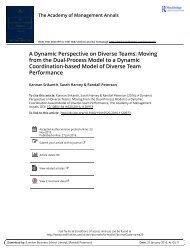The Process of Team Boundary Spanning in Multi-Organizational Contexts - Sarah Harvey, Randall S. Peterson, and N. Anand
Work teams must increasingly operate in complex environments characterized by multiple external actors beyond team and organizational boundaries. Although previous research demonstrates the importance of boundary spanning activities to team effectiveness, it reveals relatively little about the process of boundary spanning in these environments. In this article, we investigated the processes of boundary spanning across multiple external actors in 10 cross-organizational teams. We identified three sequences for reaching out to external actors: (a) moving inside-out from vertical actors inside the host organization to horizontal actors outside of the host organization, (b) moving outside-in from horizontal actors to vertical, and (c) staying-inside with vertical actors from the host organization. Our observations suggest that inside-out and outside-in sequences were more successful than simply pleasing the host organization. We build on our empirical findings to develop a process theory of how team boundary spanning activities across multiple external actors influence team effectiveness. Our research underscores the importance of a team’s interactions with actors in its external environment beyond those in an immediate supervisory role and provides insight into the dynamics of boundary spanning in multi-organizational contexts.
Work teams must increasingly operate in complex environments
characterized by multiple external actors beyond team and organizational
boundaries. Although previous research demonstrates the importance of
boundary spanning activities to team effectiveness, it reveals relatively little
about the process of boundary spanning in these environments. In this article,
we investigated the processes of boundary spanning across multiple external
actors in 10 cross-organizational teams. We identified three sequences for
reaching out to external actors: (a) moving inside-out from vertical actors inside
the host organization to horizontal actors outside of the host organization,
(b) moving outside-in from horizontal actors to vertical, and (c) staying-inside
with vertical actors from the host organization. Our observations suggest
that inside-out and outside-in sequences were more successful than simply
pleasing the host organization. We build on our empirical findings to develop
a process theory of how team boundary spanning activities across multiple
external actors influence team effectiveness. Our research underscores the
importance of a team’s interactions with actors in its external environment beyond those in an immediate supervisory role and provides insight into the
dynamics of boundary spanning in multi-organizational contexts.
You also want an ePaper? Increase the reach of your titles
YUMPU automatically turns print PDFs into web optimized ePapers that Google loves.
<strong>Harvey</strong> et al. 511<br />
team at any po<strong>in</strong>t <strong>in</strong> time is important. This uncerta<strong>in</strong>ty makes effective<br />
boundary spann<strong>in</strong>g even more important for team effectiveness (Faraj & Yan,<br />
2009). Given that build<strong>in</strong>g a relationship with an external actor requires<br />
energy <strong>and</strong> resources, however, focus<strong>in</strong>g on one actor may harm other external<br />
relationships simply from lack <strong>of</strong> time. Moreover, <strong>in</strong> some <strong>in</strong>stances,<br />
diverse external actors’ objectives may directly conflict with one another, so<br />
that it is not possible to satisfy all actors (Rockman, Pratt, & Northcraft,<br />
2007). In fact, recent research suggests boundary spann<strong>in</strong>g may actually have<br />
negative consequences <strong>in</strong> multi-organizational contexts (Ramarajan et al.,<br />
2011). We propose that the way a team engages with different actors at different<br />
po<strong>in</strong>ts <strong>in</strong> time may <strong>in</strong>fluence its outcomes.<br />
As relatively little is known about the sequence <strong>of</strong> boundary spann<strong>in</strong>g<br />
activity <strong>in</strong> teams (Gibson & Dibble, 2012; Marrone, 2010), exist<strong>in</strong>g research<br />
can provide limited <strong>in</strong>sight <strong>in</strong>to the questions we have raised. <strong>The</strong> purpose <strong>of</strong><br />
the present research is to explore the process through which teams engage <strong>in</strong><br />
boundary spann<strong>in</strong>g activity with different external actors <strong>and</strong> to build theory<br />
to l<strong>in</strong>k that process to team effectiveness. We chose to study boundary spann<strong>in</strong>g<br />
<strong>in</strong> COTs because these teams naturally have multiple external audiences<br />
(i.e., the host organization <strong>and</strong> external constituents from whom team members<br />
are drawn). We exam<strong>in</strong>ed the process <strong>of</strong> boundary spann<strong>in</strong>g from the<br />
beg<strong>in</strong>n<strong>in</strong>g <strong>of</strong> a team’s life through to the execution stage, which allowed us to<br />
capture the periods dur<strong>in</strong>g which a large amount <strong>of</strong> boundary spann<strong>in</strong>g activity<br />
was likely to take place.<br />
Research Context<br />
<strong>The</strong> sett<strong>in</strong>g for this study was a university-l<strong>in</strong>ked state Cooperative Extension<br />
System (CES). <strong>The</strong> CES was established to dissem<strong>in</strong>ate research from the<br />
colleges established with the L<strong>and</strong>-Grant Act <strong>of</strong> 1862, which gave each state<br />
l<strong>and</strong> for a university to provide research <strong>and</strong> tra<strong>in</strong><strong>in</strong>g <strong>in</strong> agriculture <strong>and</strong><br />
mechanics. <strong>The</strong> CES was designed to achieve two <strong>in</strong>terrelated goals: to put<br />
academic research to direct use <strong>in</strong> the community <strong>and</strong> to keep academic<br />
researchers abreast <strong>of</strong> community or citizen issues—thus br<strong>in</strong>g<strong>in</strong>g the university<br />
<strong>and</strong> the state’s citizens <strong>in</strong> closer alignment.<br />
<strong>The</strong> specific CES that we studied provides an appropriate research context<br />
because its central mission is accomplished almost exclusively through COTs<br />
whose members are drawn from both a host organization (the university), <strong>in</strong><br />
which the teams are formally housed, <strong>and</strong> stakeholder groups outside <strong>of</strong> the<br />
host organization (e.g., community groups <strong>and</strong> state government agencies). It<br />
therefore provides an extreme sett<strong>in</strong>g <strong>in</strong> which a team’s need to engage with<br />
organizations <strong>in</strong> its external environment is brought to the surface. This is<br />
Downloaded from sgr.sagepub.com at London Bus<strong>in</strong>ess School Library on September 24, 2014
















